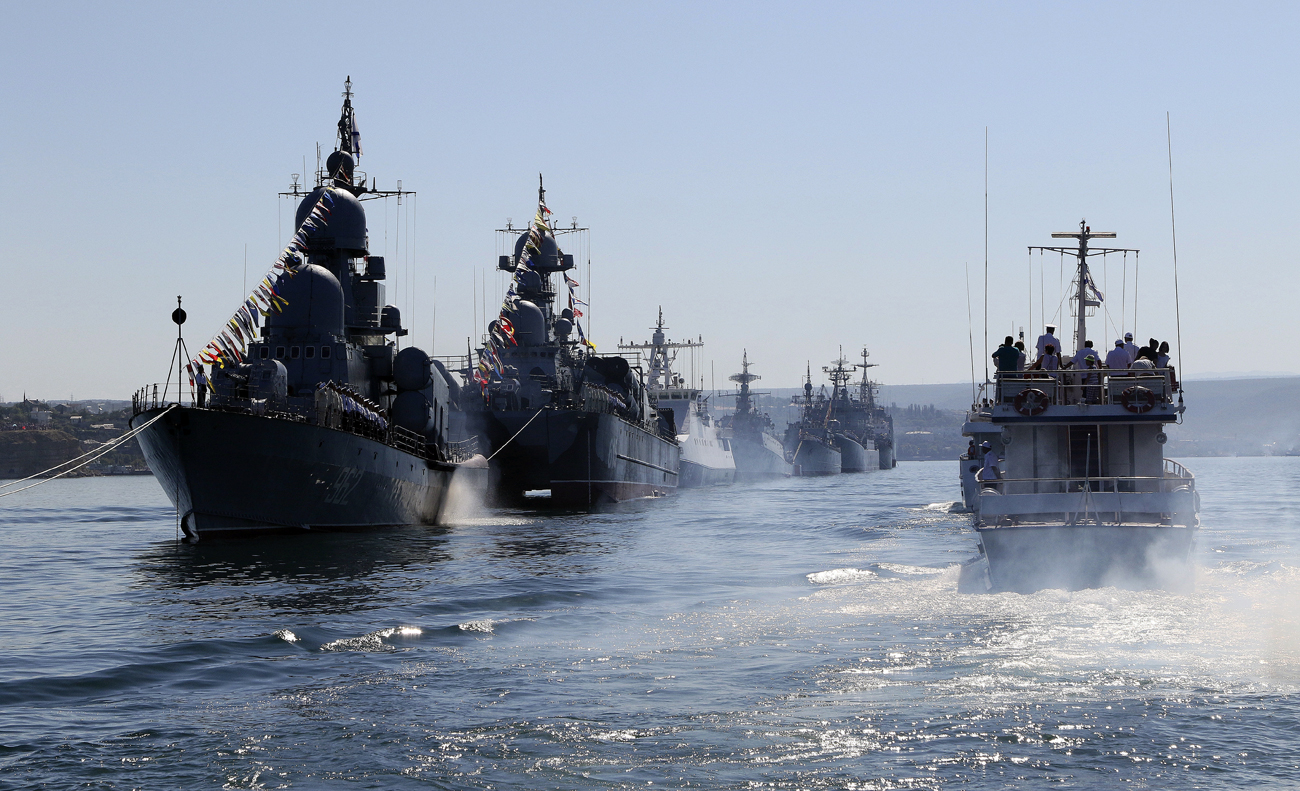
Russian warships are seen during a rehearsal for the Navy Day parade in Sevastopol, Crimea.
ReutersSince October 2015 the Russian Navy has been conducting combat operations against the ISIS militants in Syria. Today the fight against terrorism is becoming one of the navy's priorities and unprecedented funds are being invested in the construction of new ships, bases and infrastructure.
But the story is not just about Syria. Moscow has been aware for some time of the need to modernize its aging fleet, which was allowed to fall into stagnation in the two decades following the disintegration of the Soviet Union. In 2011-2012 Russia invested 5 trillion rubles ($78 billion) in the construction of new ships and submarines for the navy.
Work is currently being carried out on a series of six frigates from the Admiral Grigororovich 11356 project. The Russian Navy is about to receive the third vessel from the project.
The Russian defense industry has constructed six Varshavyanka diesel-electric submarines from the 636.3 project for the Black Sea Fleet. These submarines are equipped with the new winged Caliber-PL missiles, which can strike targets up to 1,500 miles away.
"The capacities of the new submarines were first demonstrated at the end of last year when the Rostov-on-Don submarine used its Calibers to destroy several terrorist facilities in Syria," said Igor Kasatonov, former Deputy Commander-in-Chief of the Russian Navy and former commander of the Black Sea Fleet.
The launch of the Calibers from the Rostov-on-Don 636.6 submarine. Source: Минобороны России/YouTube
According to Kasatonov, defense industry enterprises will build six equivalent submarines for the Pacific Ocean Fleet. "The industry is also building a series of strategic missile submarine cruisers from the 955 Borei project," he said. The navy has received three of these submarines and will obtain another five by 2020.
The Russian Defense Ministry's main resources are now being invested in the modernization of submarine bases in the Far East, in the city of Vilyuchinsk in the Kamchatka Region (4,150 miles east of Moscow) and in Novorossiysk on the Black Sea coast (940 miles south of Moscow). Four subs from the 995 Borei project are destined for the Kamchatka base and four will be sent to the North Fleet docks.
Three Varshavyanka 636.6 diesel subs with the Caliber winged missiles are currently on alert in Novorossiysk and within three years, after the construction of all the navy infrastructure is complete, the base will receive the other three subs from the series.
Russian experts say that the new program has taken into account the mistakes that the USSR made in the late 1970s and early 1980s, when large Krechet aircraft carriers from the 1143 project were introduced to the navy. The fleet received the vessels but there was no infrastructure to service them and they were forced to remain in the docks on a permanent basis, producing electricity with their diesel engines and burning up their resources, something that resulted in them being written off prematurely. Now an entire series of coastal infrastructure is being created for each ship and submarine.
"Today the navy needs large helicopter carriers, since they transport military cargo and aviation groups to areas of combat operations. Currently for Russia this is Syria," explained Dmitry Safonov, military observer at the Izvestiya newspaper.
In his words, one such helicopter carrier can replace an entire airbase like the one at Khmeimim in Syria.
"Russia is now working on a project to build Priboi large helicopter carriers. It will be completed in 2025 along with the Leader nuclear destroyer and the new Shtorm aircraft carriers, the project for which was presented to the world in mid-2015," added Safonov.
Experts note that today Russia has only one military base outside the boundaries of the former Soviet Union – in Syria.
"Russia does not intend to compete with America in terms of the quantity of ships, bases and presence in the world oceans," said Safonov. However, he believes that the new aircraft carriers and helicopter carriers will help Moscow project its power, like Washington, in any place on Earth.
One of the key problems of Russia's fleet today is the absence of engines and replacement parts that were previously made by Ukrainian enterprises.
Among the largest "lost" contracts is the agreement with the Zorya-Mashproekt company, located in the Ukrainian city of Nikolayev. The agreement concerned the supply of six turbine engines for patrol boats from the 11356 project.
"Before the crisis in relations with Ukraine, Russia had received only three of the six engines. As a result, three of the ships from the 11356 project will be "inactive" until 2018 when Russia will set up its own production of these engines," editor-in-chief of the Arsenal Otechestva military magazine Viktor Murakhovsky told RBTH.
According to Murakhovsky, one of the pressing issues is the repair of "Soviet heritage" ships and their modernization. "We have a large number of missile cruisers and destroyers of Soviet make," he said. A number of these ships are incapable of executing combat missions but they have still not been written off from the fleet.
In order for them to be repaired it is necessary to construct new shipbuilding factories and expand the old ones. These projects require substantial financial investments and progressive long-term work, said Murakhovsky.
All rights reserved by Rossiyskaya Gazeta.
Subscribe
to our newsletter!
Get the week's best stories straight to your inbox